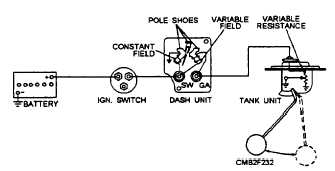
Figure 2-80. - Magnetic fuel gauge.
pressure, and the pressure in the hydraulic systems. Depending on the equipment, a mechanical gauge, an electrical gauge, or an indicator lamp may be used.
The MECHANICAL GAUGE (fig. 2-81) uses a thin tube to carry an actual pressure sample directly to the gauge. The gauge basically consists of a hollow, flexible C-shaped tube, called a bourbon tube. As air or fluid pressure is applied to the bourbon tube, it will tend to straighten out. As it straightens, the attached pointer will move, giving a reading.
The ELECTRIC GAUGE may be of the thermostatic or magnetic type as previous discussed. The sending unit (fig. 2-82) that is used with each gauge type varies as follows:
1. The sending unit that is used with the thermostatic pressure gauge uses a flexible diaphragm that moves a grounded contact. The contact that mates with the grounded contact is attached to a bimetallic strip. The flexing of the diaphragm, which is done with pressure changes, varies the point tension. The different positions of the diaphragm produce gauge readings.

Figure 2-81. - Mechanical pressure gauge.
2. The sending unit that is used with the magnetic-type gauge also translates pressure into the flexing of a diaphragm. In the case of the magnetic gauge sending unit, however, the diaphragm operates a rheostat.
The INDICATOR LAMP (warning light) is used in place of a gauge on many vehicles. The warning light, although not an accurate indicator, is valuable because of its high visibility in the event of a low-pressure condition. The warning light receives battery power through the ignition switch. The circuit to ground is completed through a sending unit. The sending unit consists of a pressure-sensitive diaphragm that operates a set of contact points that are calibrated to turn on the warning light whenever pressure drops below a set pressure.
TEMPERATURE GAUGE
The temperature gauge is a very important indicator in construction and automotive equipment. The most common uses are to indicate engine coolant, transmission, differential oil, and hydraulic system temperature. Depending on the type of equipment, the gauge may be mechanical, electric, or a warning light.
The ELECTRIC GAUGE may be the thermostatic or magnetic type, as described previously. The sending unit (fig. 2-83) that is used varies, depending upon application.
1. The sending unit that is used with the thermostatic gauge consists of two bimetallic strips, each having a contact point. One bimetallic strip is heated electrically. The other strip bends to increase the tension of the contact points. The different positions of the bimetallic strip create the gauge readings.
2. The sending unit that is used with the magnetic gauge contains a device called a thermistor. A thermistor is an electronic device whose resistance decreases proportionally with an increase in temperature.
The MAGNETIC GAUGE contains a bourbon tube and operates by the same principles as the mechanical pressure gauge.
The INDICATOR LAMP (warning light) operates by the same principle as the indicator light previously discussed.Continue Reading
